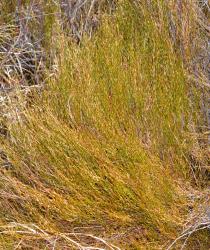- Taxon
- Gallery
- ≡ Calorophus minor Hook.f., Bot. Antarct. Voy. II. (Fl. Nov.-Zel.) Part I, 267 (1853)
- ≡ Calorophus elongatus var. minor (Hook.f.) Hook.f., Bot. Antarct. Voy. III. (Fl. Tasman.) Part II, 75 (1858)
- ≡ Hypolaena lateriflora var. minor (Hook.f.) Cheeseman, Man. New Zealand Fl. 762 (1906)
Rhizome very stout compared to stems, erect, up to 8 mm. diam., covered with light brown, overlapping, scale-like sheaths and very thick tufts of brown hairs; roots ∞, 1–1.5 mm. diam., densely covered by persistent root hairs. Culms (8)–15–40–(120) cm. × (0.5)–1–1.5 mm., much-branched, flexuous, terete or grooved on one side, glab., bright green or bronze-brown, erect when short, procumbent when longer. Lvs reduced to mucronate sheaths, closely appressed to culm, distant, green at first, later dark brown, rigid, margin entire; the cilia protruding through the mouth of the sheath in tufts of white crinkled hairs arise from the outer scale of an axillary bud within the sheath; mucro long, fine, sharp-pointed, recurved or erect. Spikelets distant within uppermost sheaths. Male spikelets solitary or us. 2, 1 sessile and 1 stalked, within each hard, mucronate sheath, 1–4–(6)–fld; ♂, tepals 6, narrow-linear, acute; stamens 3, filaments slender, > tepals, anthers exserted beyond the floral bract. Female spikelets solitary within 1–3 uppermost, bearded, obtuse sheaths, 1-fld, with 2 imbricate, empty floral bracts; ♀, tepals 6–4, very small, hyaline; styles 3, free. Fr. a hard, oval nut, > persistent tepals, sessile on a thick receptacle. 2n = 24.
[From: Moore and Edgar (1970) Flora of New Zealand. Volume 2 as Calorophus minor Hook.f.]




